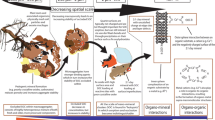Abstract
Humic substances are heterogeneous mixtures of organic compounds occurring in huge amounts mainly in waters, soils, sediments and organic wastes. They are formed during the decay of living organisms. They play a very important role in many environmental processes including carbon sequestration, water cleaning and retention, soil erosion, fertility and pollutant retention. However, due to their complex nature, humic substances are still poorly characterized and much less known than living matter. Humin is the most insoluble and, in turn, the least understood fraction of humic substances. To our knowledge, no information is currently available on the adsorption and desorption behaviors of metal ions on soil humin. Here, we report the adsorption and desorption properties of Cu(II) on humin and humic acids isolated from a forest soil in northeast China using the batch equilibration method. Solid-state 13C cross-polarization magic angle spinning nuclear magnetic resonance (13C CPMAS NMR) spectroscopy was used to characterize and compare the chemical structures of humin and humic acid. The batch experiments’ results show that humin has a lower adsorption capacity and higher adsorption reversibility for Cu(II) than humic acid. The adsorption isotherms well fitted both the Langmuir and Freundlich equations. Humin, therefore, plays an important role in controlling the fate, transport and bioavailability of Cu(II) in the environment. The 13C CPMAS NMR spectra showed that compared with humic acid, humin was higher in alkyl C, carbohydrate C and phenolic C and was lower in methoxyl C, aryl C and carbonyl C. These findings mean that humin was less alkylated, more aliphatic and more hydrophobic.



Similar content being viewed by others
References
Aiken GR, McKnight DM, Wershaw RL, MacCarthy P (1985) Humic substances in soil, sediment, and water: geochemistry, isolation, and characterization. Wiley, New York
Alvarez-Puebla RA, Valenzuela-Calahorro C, Garrido JJ (2004) Modeling the adsorption and precipitation of Cu(II) on humin. J Colloid Interface Sci 277:55–61
Alvarez-Puebla RA, Aroca RF, Valenzuela-Calahorro C, Garrido JJ (2006) Retention of cobalt on a humin derived from brown coal. J Hazard Mater 135:122–128
Cerqueira B, Covelo EF, Andrade L, Vega FA (2011) The influence of soil properties on the individual and competitive sorption and desorption of Cu and Cd. Geoderma 162:20–26
Contreras C, de la Rosa G, Peralta-Videa JR, Gardea-Torresdey JL (2006) Lead adsorption by silica-immobilized humin under flow and batch conditions: assessment of flow rate and calcium and magnesium interference. J Hazard Mater 133:79–84
de la Rosa G, Peralta-Videa JR, Gardea-Torresdey JL (2003) Utilization of ICP/OES for the determination of trace metal binding to different humic fractions. J Hazard Mater 97:207–218
Gardea-Torresdey JL, Tang L, Salvador JM (1996) Copper adsorption by esterified and unesterified fractions of Sphagnum peat moss and its different humic substances. J Hazard Mater 48:191–206
Gunasekara AS, Xing B (2003) Sorption and desorption of naphthalene by soil organic matter: importance of aromatic and aliphatic components. J Environ Qual 32:240–246
Havelcová M, Mizera J, Sýkorová I, Pekař M (2009) Sorption of metal ions on lignite and the derived humic substances. J Hazard Mater 161:559–564
Lichtfouse E (1999) A novel model of humin. Analusis 27:385–386
Lichtfouse E (2012) 13C-dating, the first method to calculate the relative age of molecular substance homologues in soil. Environ Chem Lett 10:97–103
Rice JA (2001) Humin. Soil Sci 166:848–857
Stevenson FJ (1994) Humus chemistry: genesis, composition, and reactions. Wiley, New York
Vega FA, Covelo EF, Andrade ML (2009) Hysteresis in the individual and competitive sorption of cadmium, copper and lead by various soil horizons. J Colloid Interface Sci 331:312–317
Xing BS, Liu JD, Liu XB, Han XZ (2005) Extraction and characterization of humic acids and humin fractions from a black soil of China. Pedosphere 15:1–8
Zhang J, Dai J, Wang R, Li F, Wang W (2009a) Adsorption and desorption of divalent mercury (Hg2+) on humic acids and fulvic acids extracted from typical soils in China. Colloids Surf A Physicochem Eng Aspects 335:194–201
Zhang J, He M, Shi Y (2009b) Comparative sorption of benzo[α]phrene to different humic acids and humin in sediments. J Hazard Mater 166:802–809
Zhang JJ, Dou S, Song XY (2009c) Effect of long-term combined nitrogen and phosphorus fertilizer application on 13C CPMAS NMR spectra of humin in a Typic Hapludoll of northeast China. Eur J Soil Sci 60:966–973
Zhang JJ, Hu F, Li HX, Gao Q, Song XY, Ke XK, Wang LC (2011) Effects of earthworm activity on humus composition and humic acid characteristics of soil in a maize residue amended rice-wheat rotation agroecosystem. Appl Soil Ecol 51:1–8
Acknowledgements
This work was financially supported by the National Basic Research Program of China (2009CB118600), the National Agricultural Department Public Benefit Research Foundation (201103003), the Postdoctoral Project of Jilin Province (Grant No. 01912) and the Postdoctoral Project of Northeast Agricultural Research Centre of China (Grant No. 00225). The authors wish to thank Ming Qin and Yong Wang for assistance in the laboratory work, and Dr. Zijiang Jiang for his technical support in solid-state 13C CPMAS NMR spectroscopy. We would also like to express our great appreciation to two anonymous reviewers and Dr. Eric Lichtfouse, the Editor-in Chief, for their valuable comments and suggestions.
Author information
Authors and Affiliations
Corresponding authors
Rights and permissions
About this article
Cite this article
Zhang, J., Wang, S., Wang, Q. et al. First determination of Cu adsorption on soil humin. Environ Chem Lett 11, 41–46 (2013). https://doi.org/10.1007/s10311-012-0375-1
Received:
Accepted:
Published:
Issue Date:
DOI: https://doi.org/10.1007/s10311-012-0375-1




